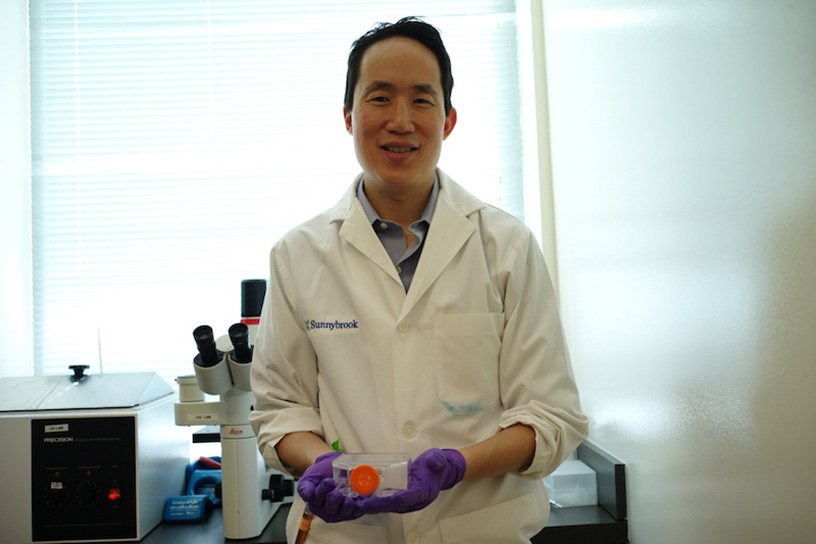A timely investment
Two clinician-scientists at Sunnybrook Research Institute were recognized with an Early Researcher Award (ERA) from the Ontario Ministry of Research, Innovation and Science. The award, worth $100,000, invests in new researchers by helping them build their teams. An additional $40,000 is given to cover indirect costs, such as the operation and maintenance of facilities and equipment.
Dr. Stanley Liu, a scientist in the Biological Sciences platform, received an ERA to advance his research into how microRNAs work in cancer cells.
Prior to their discovery in 1993 microRNAs were believed to be junk DNA with no function, mainly because they are very short—about 22 letters long. In contrast, a human gene containing instructions to make a protein is several thousand letters long. MicroRNAs are not part of the 2% of the human genome that codes for proteins, which are responsible for nearly all cell activity; nevertheless, they can block cells from making proteins. “They can regulate gene expression; so, control how many and what type of proteins are produced. That can influence the behaviour of cancer cells,” says Liu.
Researchers have found more than 1,800 human microRNAs. They now know that these small RNA molecules are involved in many processes, including cell death, stem cell differentiation, new blood cell creation, metabolism and immune response. Liu is contributing to this burgeoning field by uncovering how microRNAs make cancer cells aggressive and resistant to radiation treatment, phenomena in which he, as a radiation oncologist, is particularly interested.
In 2013 his team published a paper in Cancer Research showing for the first time that prostate cancer cells that survived radiation were enriched with a microRNA called miR-95. They did this by taking prostate cancer cells that had withstood radiation treatment and sequencing their microRNAs; they discovered miR-95 was highly expressed in these cells. To confirm this link, his team engineered cancer cells to make more miR-95. They were gratified to see their initial findings validated. “It [miR-95] mimics what happens in radio-resistance—the cells survive radiation, grow faster, invade more and resist [subsequent] radiation,” says Liu.
What role does miR-95 have in radiation resistance? Liu found it suppresses a gene that turns off a specific signalling pathway that mediates aggression in cancer cells. When this pathway is turned on cancer cells are more likely to endure DNA-damaging radiation and allow tumours to make more blood vessels.
Liu’s goal is to improve outcomes for men with prostate cancer. “Understanding the mechanisms will eventually lead us to determine which pathways are deregulated, so we can target those to overcome radio-resistance,” he says.
The discovery of miR-95 and its function is an important first step in exposing the behaviour of malignant cells, but there is more work to be done, says Liu, whose group is on the hunt for more microRNAs. “The reality of the situation is that it’s never going to be just one microRNA. We are exploring the function of additional microRNAs that influence cancer behaviour and treatment response,” he says.
Liu is also investigating whether microRNAs can be used as biomarkers to guide treatment of prostate cancer. MicroRNAs are secreted in bodily fluids such as saliva, urine and blood, making them easy to collect. They are also stable; because they are so small, they don’t get degraded.
If microRNAs are proven to be effective biomarkers of aggressive disease, then the effects would be “profound,” says Liu. Men could be offered personalized therapy based on the genetic profile of their disease. For example, men who, after an initial biopsy, are classified as having low-risk prostate cancer but whose microRNA signature suggests a higher chance of having invasive disease could have a repeat biopsy right away rather than waiting months until the next scheduled test. If the biomarkers suggest a greater likelihood of the cancer being resistant to radiation, then the patient could be offered surgery, or given higher doses of radiation. Another option would be to offer hormone therapy or chemotherapy in addition to radiation. “There are a multitude of opportunities,” he says.
A key to his success is the mentorship he receives from established researchers such as Drs. Rob Bristow and Andrew Loblaw, and the supportive environment of the genitourinary cancer group at Sunnybrook’s Odette Cancer Centre. In turn, Liu aims to offer his trainees guidance. His ERA will support his research through funding his graduate students’ salaries. “It’s a very important program. You’re creating new knowledge, and you’re training people at the same time, which is great.”
Dr. Andrea Gershon, a scientist in the Evaluative Clinical Sciences platform, also received an ERA. She is analyzing “big data” on people in Ontario who are diagnosed with chronic obstructive pulmonary disease, a lung disease that makes it hard to breathe. Gershon, who is a respirologist, will uncover the reasons why poor quality care exists and how to improve treatment of this disease.






